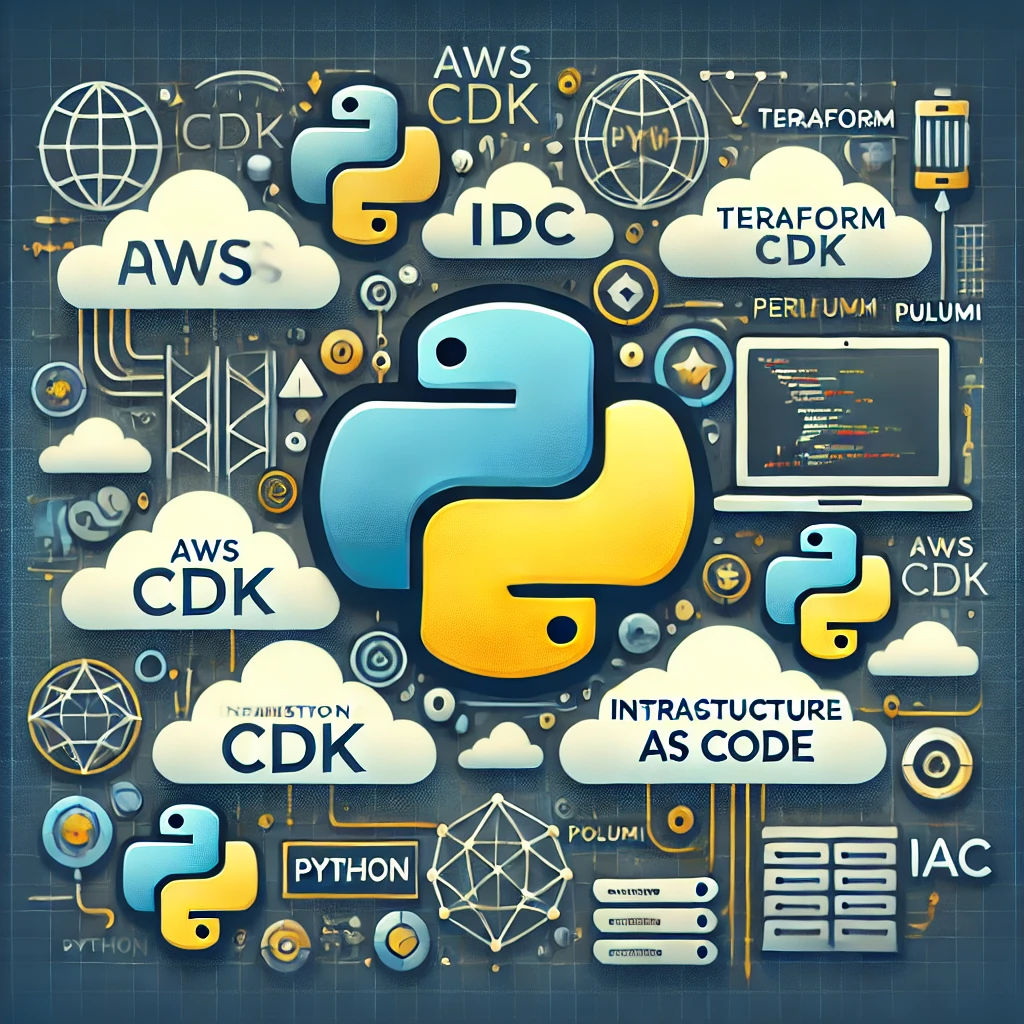Exploring Infrastructure as Code with Python: AWS CDK, Terraform CDK, and Pulumi
 Alex Idowu
Alex Idowu
Infrastructure as Code (IaC) is revolutionizing how we manage and deploy cloud infrastructure, enabling consistency, scalability, and automation. This post is inspired by a talk I gave at this year’s PyCon, where I explored how Python integrates with IaC tools like AWS CDK, Terraform CDK, and Pulumi. To further assist developers, I've also created a GitHub repository containing starter examples and guides on using these tools, which you can find here.
What is Infrastructure as Code (IaC)?
At its core, Infrastructure as Code (IaC) refers to managing and provisioning computing infrastructure through machine-readable configuration files rather than manual processes. By automating the deployment and management of infrastructure, IaC ensures consistency, version control, and idempotency—allowing teams to deploy infrastructure repeatedly without unintended changes.
Key Features of IaC:
Consistency: Automates infrastructure setups, reducing the risk of human error.
Version Control: Like application code, infrastructure can be tracked and versioned, ensuring full visibility into every change.
Idempotency: Re-running IaC scripts doesn’t alter existing infrastructure unnecessarily, reducing deployment risks.
Why Python for IaC?
Python is a great language for Infrastructure as Code due to its rich ecosystem of libraries and frameworks such as Boto3, Ansible, and the AWS Cloud Development Kit (CDK). Its strong community and extensive toolchain make Python an ideal choice for developers looking to automate infrastructure setups.
Benefits of Using Python for IaC:
Rich Ecosystem: Python’s libraries like AWS CDK, Pulumi, and Terraform CDK make it incredibly versatile.
Familiarity: For Python developers, IaC feels like an extension of their existing skill set, eliminating the need to learn new languages.
Tooling Integration: Python integrates seamlessly with testing, dependency management, and CI/CD workflows.
Python-Based IaC Tools: A Closer Look
1. AWS Cloud Development Kit (AWS CDK)
The AWS CDK is a framework for defining AWS cloud resources using programming languages, including Python. It simplifies infrastructure management by allowing developers to describe AWS resources using high-level constructs and then deploy them via AWS CloudFormation.
Features of AWS CDK:
Declarative and Imperative: Combines the best of both worlds by allowing you to use programming logic alongside declarative CloudFormation.
State Management: Leverages AWS CloudFormation to manage the state of your AWS resources.
Example Use Case: Provisioning S3 buckets, DynamoDB tables, or Lambda functions with Python code.
from aws_cdk import core
from aws_cdk.aws_s3 import Bucket
class MyStack(core.Stack):
def __init__(self, scope: core.Construct, id: str, **kwargs) -> None:
super().__init__(scope, id, **kwargs)
bucket = Bucket(self, "MyBucket")
2. Terraform CDK (CDKTF)
The Terraform CDK (CDKTF) extends Terraform’s infrastructure management capabilities by allowing users to define infrastructure in programming languages like Python. It combines Terraform’s robust state management and provider ecosystem with Python's flexibility.
Features of Terraform CDK:
Multi-cloud: Supports AWS, GCP, Azure, and other cloud providers.
Combines Terraform’s Power with Python: Developers can use Python for defining infrastructure while benefiting from Terraform’s mature provider ecosystem.
Example Use Case: Creating infrastructure on AWS, Azure, or GCP using Python and Terraform.
from cdktf import App, TerraformStack
from cdktf_cdktf_provider_aws import AwsProvider, Instance
class MyStack(TerraformStack):
def __init__(self, scope: Construct, id: str):
super().__init__(scope, id)
AwsProvider(self, 'AWS', region='us-east-1')
instance = Instance(self, 'Compute', ami='ami-123456', instance_type='t2.micro')
app = App()
stack = MyStack(app, 'my-stack')
app.synth()
3. Pulumi
Pulumi allows developers to write infrastructure code using general-purpose programming languages like Python, JavaScript, and Go. It provides a more developer-friendly experience compared to traditional IaC tools by fully embracing modern development practices.
Features of Pulumi:
Multi-language support: Define infrastructure in Python, TypeScript, Java, etc.
Cloud-agnostic: Supports AWS, Azure, Google Cloud, and Kubernetes.
State Management: Manages the state of cloud resources automatically.
Example Use Case: Deploying AWS Lambda functions and other resources using Python.
import pulumi
import pulumi_aws as aws
bucket = aws.s3.Bucket('my-bucket')
lambda_func = aws.lambda_.Function('my-function',
code=pulumi.FileArchive('lambda.zip'),
handler='index.handler',
runtime='python3.8')
pulumi.export('bucket_name', bucket.id)
Choosing the Right Tool
Each tool has its strengths, and the best choice depends on your specific needs:
AWS CDK: Great for teams heavily using AWS services.
Terraform CDK: Ideal if you want to extend Terraform’s capabilities with Python and manage multi-cloud infrastructure.
Pulumi: Best suited for those who want a modern developer experience with support for multiple languages and cloud platforms.
Conclusion
Infrastructure as Code is crucial for managing scalable cloud infrastructure efficiently, and Python makes it even easier by integrating with tools like AWS CDK, Terraform CDK, and Pulumi. Whether you're deep into AWS or need to manage resources across multiple providers, these Python-based tools offer flexibility and power for automating your cloud infrastructure.
For more hands-on examples and starter guides, check out my GitHub repository: GitHub Repo.
Resources:
Let me know your thoughts in the comments, and feel free to reach out if you have any questions about Infrastructure as Code!
About the Author
Alex Idowu is the CTO of PipeOps, a platform focused on simplifying cloud infrastructure management. He has a passion for distributed systems and enjoys exploring ways to make infrastructure more scalable and manageable. This post is based on his PyCon 2024 talk on Infrastructure as Code.
Subscribe to my newsletter
Read articles from Alex Idowu directly inside your inbox. Subscribe to the newsletter, and don't miss out.
Written by

Alex Idowu
Alex Idowu
👩🏻💻 Cloud Infrastructure and Software Engineer 🚀, ✨ Open Sourcerer, I am Groot